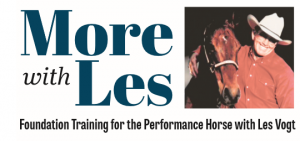 Last issue, Les demonstrated use of a light brace rein to keep shoulders out of the way. Now, let’s work on turns on the forehand.
Last issue, Les demonstrated use of a light brace rein to keep shoulders out of the way. Now, let’s work on turns on the forehand.
Start by walking along the fence. Pick a point to stop the horse and then make a very light contact with your inside (away from the fence) rein while you reach back with your fence-side leg and push or bump your horse’s hip around. You’re creating energy with your leg to push the hip, and your brace rein contact will lightly block him from pushing through with his shoulder. With the fence in front of him you don’t give your horse any other options but to move his hip. Do this exercise repeatedly (it’s called a turn on the forehand) both directions. Start by just asking for a step at a time and then increase the number of steps as your horse’s responses get more consistent. Remember to keep life in your reins and leg as you ask for this exercise.
Since you don’t want to do the exercise if it’s not perfect, don’t ask for the hip if you don’t have the nose. You need to insist that the horse maintain a soft poll, with no resistance, as you attempt the exercise. If you find that he’s continuously trying to move his shoulder over before his hip, go off and work on exercise number two, shoulder control, to get him more responsive to your brace rein.
For this exercise, you need to make sure that you’re cuing your horse with your leg as far back as you can comfortably reach. When done consistently, this will let him
know that you want him to move his hips only.
To check yourself, find a place on the rail right next to a fencepost. Now move the horse’s hips back and forth, both ways, with his nose right on that post. When you can do it you’ll know you’ve made real progress.
Since the shoulder element of exercises number three and four is so critical, I suggest that you stay on the fence with your attempts at least until you can do both quite smoothly; we will come back to them in a few lessons and get them perfect off the rail. Staying on the fence just minimizes the horse’s alternatives and lets you pay more attention to where the shoulders are at every step. Once you are getting three or four good steps in each direction, you are ready to move on, but make sure to include these exercises in your ride every day so that you really have them down by the time we come back to them.
Leave a Comment
All fields must be filled in to leave a message.